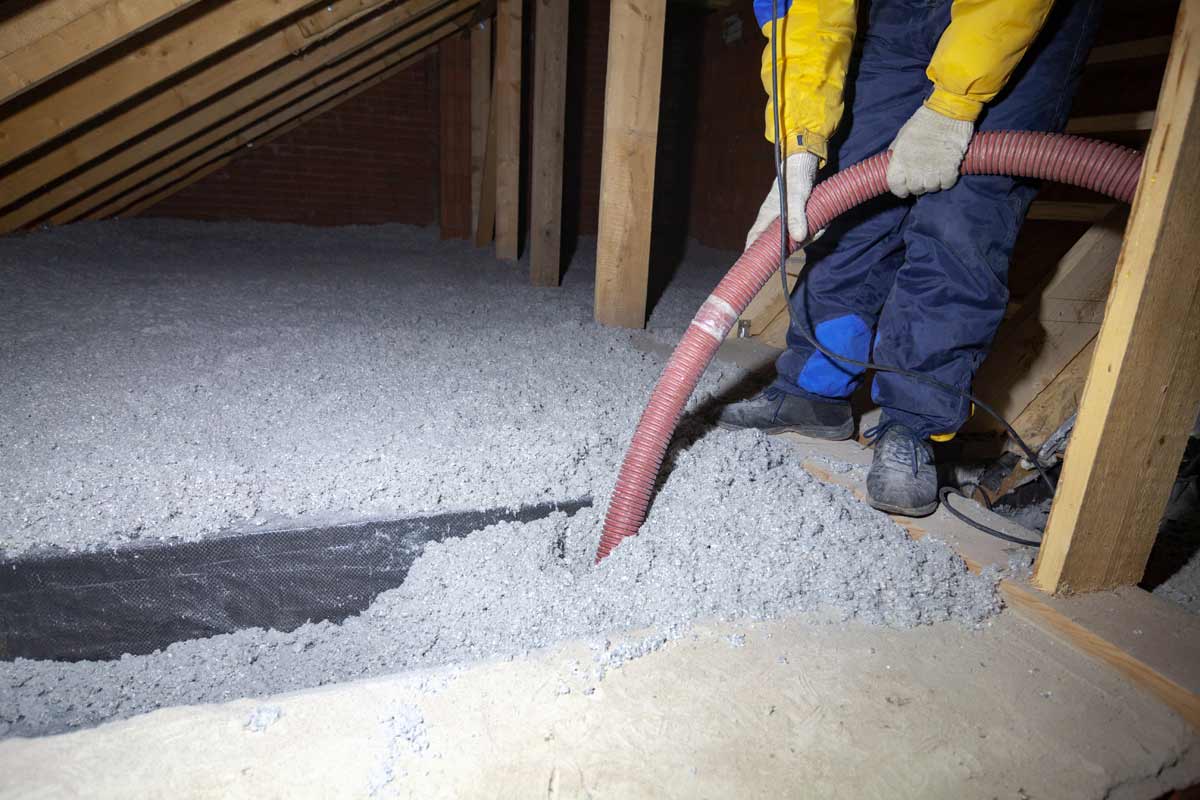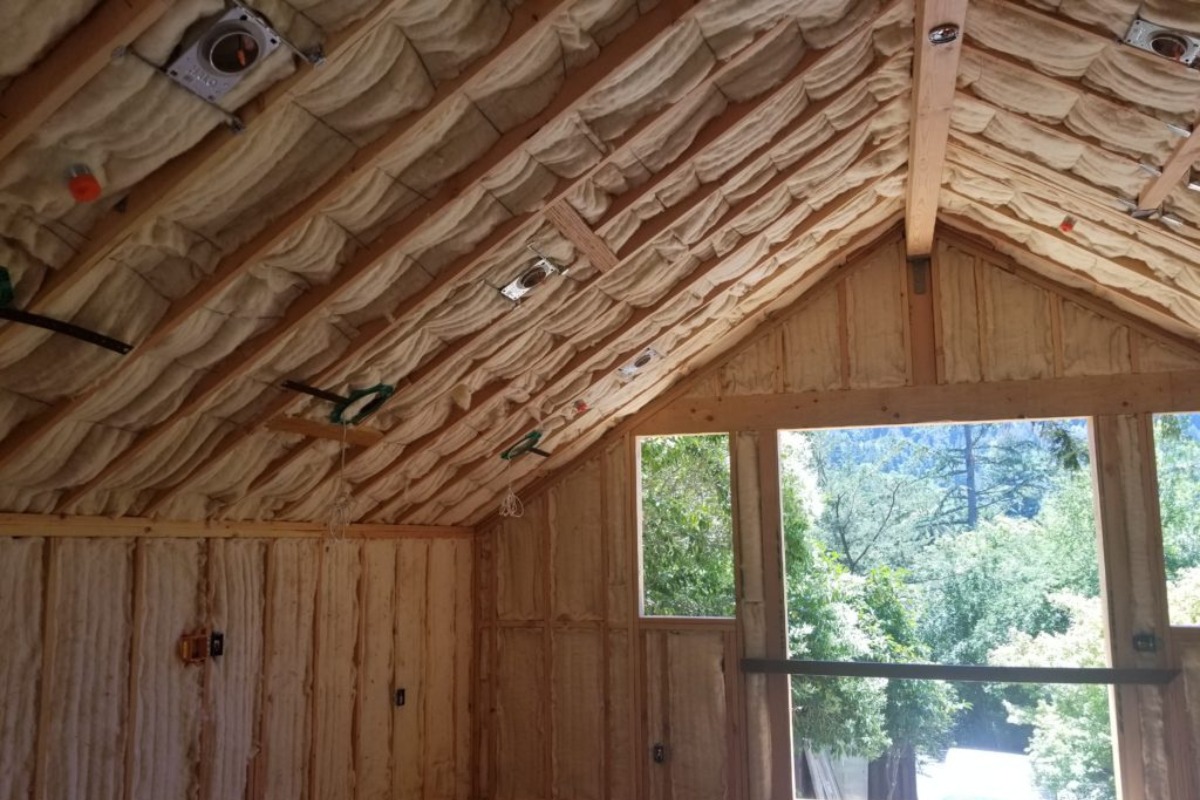

Articles
How To Calculate Floor Area Ratio
Modified: October 20, 2024
Learn how to calculate floor area ratio with our informative articles. Discover the key factors and formulas to determine the density of a building project.
(Many of the links in this article redirect to a specific reviewed product. Your purchase of these products through affiliate links helps to generate commission for Storables.com, at no extra cost. Learn more)
Introduction
Welcome to the fascinating world of urban planning! In the realm of designing cities and managing their growth, there are numerous factors to consider. One critical aspect that plays a pivotal role in urban development is the Floor Area Ratio (FAR). Understanding and calculating FAR is essential for architects, developers, and city planners.
Floor Area Ratio, often referred to as FAR, is a crucial metric used in urban planning to determine the intensity of land use in a particular area. It is a ratio that quantifies the relationship between the total floor area of a building or development and the size of the land on which it is built. By regulating FAR, cities can control the density and scale of buildings, ensuring a harmonious balance between development and open space.
The concept of FAR has gained significant importance in urban planning due to the need for sustainable and efficient land use. As cities strive to accommodate growing populations and provide adequate infrastructure, FAR calculations become a crucial tool in determining the feasibility and impact of development projects.
This article aims to guide you through the process of calculating the Floor Area Ratio. We will explore the components of the FAR formula, discuss the data required for accurate calculations, and examine real-life examples to illustrate its practical application. By the end of this article, you will have a solid understanding of how to calculate FAR and its implications in urban planning.
Key Takeaways:
- Understanding FAR is essential for balanced urban development, controlling density, promoting efficient land use, and preserving aesthetics. Accurate FAR calculations are crucial for sustainable and vibrant communities.
- FAR calculations are influenced by zoning regulations, infrastructure capacity, and environmental considerations. Practical examples illustrate the real-world application of FAR in shaping urban landscapes.
Read more: How To Calculate Area In CAD
What is Floor Area Ratio (FAR)?
Floor Area Ratio (FAR) is a planning tool used by city planners and zoning authorities to regulate the intensity of land use in a given area. It is a ratio that compares the total floor area of a building or development to the size of the plot of land on which it is built.
When determining the FAR for a specific area, city planners aim to strike a balance between the need for development and the preservation of open space. By setting limits on how much floor area can be built on a plot of land, they can control factors such as density, building height, and the overall impact on the surrounding environment.
The importance of FAR in urban planning cannot be overstated. Here are a few key reasons why it is such a critical metric:
- Managing Population Density: As cities grow, managing population density becomes crucial for ensuring a sustainable and livable environment. By setting FAR limits, city planners can control the number of people living or working in a defined area. This helps to prevent overcrowding and excessive strain on infrastructure and services.
- Promoting Efficient Land Use: Land is a limited resource in urban areas, and optimizing its use is vital. FAR regulations encourage efficient land utilization, maximizing the potential of available space. By promoting vertical development and discouraging sprawl, FAR plays a vital role in minimizing urban sprawl and preserving open and green spaces.
- Aesthetics and Urban Design: FAR helps ensure architectural harmony and visual appeal in cities. By regulating building scale and height, city planners can maintain an aesthetically pleasing environment. FAR guidelines often take into account the surrounding context, preserving important views and architectural heritage.
- Infrastructure Planning: Planning for infrastructure and public services is essential for the smooth functioning of cities. By controlling the intensity of development through FAR, city planners can ensure that the necessary infrastructure, such as roads, water supply, and sewage systems, can adequately support the population in the area.
In summary, FAR is a vital tool used by urban planners to balance the needs of development with the preservation of open space and the overall livability of cities. By controlling density, encouraging efficient land use, promoting aesthetics, and planning for infrastructure, FAR plays a crucial role in shaping the urban landscape and creating sustainable communities.
Understanding the Formula for Calculating FAR
Calculating the Floor Area Ratio (FAR) involves using a specific formula that considers various factors to determine the level of development allowed on a given plot of land. Let’s break down the components of the FAR formula and explain the terms involved.
Components of the FAR Formula
The FAR formula consists of two primary components:
- Total Floor Area: This refers to the sum of the floor areas of all buildings and structures on a particular site. It includes both residential and non-residential spaces, such as offices, retail areas, and common areas. The total floor area is typically measured in square feet or square meters.
- Site Area: The site area is the land area upon which the building or development is constructed. It represents the actual area of the plot of land and is also measured in square feet or square meters.
Explaining the Terms in the Formula
To calculate the FAR, divide the total floor area by the site area:
FAR = Total Floor Area / Site Area
Let’s dig deeper into the terms involved:
- Total Floor Area: This term represents the summation of the floor areas of all buildings within the site. It includes all levels, including basements, mezzanines, and roofs. It is important to ensure that the measurements consider both usable and non-usable spaces within the buildings.
- Site Area: The site area refers to the total land area of the site on which the development is taking place. This includes the entire area occupied by the building and any associated open spaces or landscape features. It is essential to accurately measure the site area to obtain precise FAR calculations.
By dividing the total floor area by the site area, you can determine the FAR value. This value represents the intensity of development permissible on a particular plot of land.
Understanding the components and terms in the FAR formula is crucial for accurate calculations. By taking into account the total floor area and site area, city planners can assess the level of development allowed, ensuring that it is in line with the city’s urban planning goals.
Read more: How To Calculate The Construction Area
Collecting the Required Data
Calculating the Floor Area Ratio (FAR) requires accurate and reliable data. To begin the calculation process, it is important to identify the necessary information and determine the sources from which you can acquire the data. Let’s explore the details of collecting the required data for calculating FAR.
Identifying Necessary Information
When calculating FAR, the following information is crucial:
- Total Floor Area: To determine the total floor area, you will need detailed information about the buildings and structures on the site. This includes the floor area of each building, including the basement, mezzanine, and rooftop spaces. It is essential to consider both residential and non-residential areas within the buildings.
- Site Area: Accurate measurement of the site area is essential. You need to know the exact size of the land plot on which the development is taking place. This includes the area occupied by buildings as well as any associated open spaces or landscape features.
- Regulations and Restrictions: Familiarize yourself with the relevant zoning regulations, building codes, and any specific FAR requirements set by local authorities. These regulations may specify additional criteria or restrictions that need to be considered during the calculation process.
Sources for Acquiring Data
To collect the necessary data for calculating FAR, you can utilize various sources:
- Building Plans and Blueprints: Access architectural plans and blueprints of the buildings on the site. These documents typically include detailed floor plans and measurements that can help determine the total floor area accurately.
- Site Surveys: Conduct a land survey to obtain accurate measurements of the site area. A professional surveyor can provide precise measurements, taking into account any irregularities or unique features of the land.
- Local Planning Departments: Consult with local planning departments or zoning authorities to gather information on the FAR regulations specific to the area. They can provide guidelines, zoning maps, and relevant documents to ensure compliance with local regulations.
- Online Databases and Tools: Utilize online databases and tools that provide access to building information, land records, and zoning data. These resources can assist in obtaining data quickly and efficiently.
By identifying the necessary information and utilizing reliable sources, you can ensure accurate data collection for calculating FAR. It is crucial to maintain precise measurements and adhere to the regulations and restrictions set by local authorities to obtain reliable and meaningful FAR values.
Calculating the Total Floor Area
Calculating the total floor area is a crucial step in determining the Floor Area Ratio (FAR) for a specific development site. The total floor area includes all the floor spaces within the buildings on the site, encompassing both residential and non-residential areas. Let’s take a look at the step-by-step process for calculating the total floor area.
Read more: How To Calculate Attic Ventilation Area
Step 1: Gather Detailed Building Information
Start by collecting detailed information about each building on the site. This includes architectural plans, blueprints, or any available documentation that provides accurate measurements of the floor areas. It is important to consider all levels of the building, including basements, mezzanines, and rooftop spaces. Ensure that you have access to the most up-to-date and comprehensive information for accurate calculations.
Step 2: Measure the Floor Area of Each Building
Using the gathered building information, measure the floor area of each building individually. This involves calculating the area of each floor within the building. If the building has multiple wings or sections, take measurements for each section separately.
You can calculate the floor area by multiplying the length and width of each floor or using more complex methods such as the use of computer software or the assistance of a professional surveyor. Ensure that the measurements are taken accurately, accounting for any irregular shapes or unique features within the floor spaces.
Step 3: Sum up the Floor Areas of All Buildings
Once you have determined the floor area for each building, sum up the individual floor areas to obtain the total floor area. This involves adding together the floor areas of all the buildings on the site. Take into account any shared or common areas, such as lobbies, hallways, or staircases.
Step 4: Include Non-Usable Spaces
It is important to remember that the total floor area should account for both usable and non-usable spaces within the buildings. Non-usable spaces can include areas such as mechanical rooms, storage rooms, or utility spaces. These areas contribute to the total floor area but might not be occupiable or suitable for human use.
Step 5: Verify and Review the Calculated Total Floor Area
Double-check your calculations and review the calculated total floor area. Ensure that all necessary measurements and areas have been considered accurately. If possible, have another person review the calculations to reduce the risk of errors.
By following these step-by-step processes, you can accurately calculate the total floor area, which is a crucial component in determining the Floor Area Ratio (FAR). Remember to maintain precise measurements and consider both usable and non-usable spaces within the buildings to obtain reliable and meaningful results.
Calculating the Site Area
Calculating the site area is an essential step in determining the Floor Area Ratio (FAR) for a development project. The site area represents the total land area on which the development is taking place. Accurate measurement of the site area is crucial for obtaining precise FAR calculations. Let’s explore the process of calculating the site area, including determining the size of the site and incorporating relevant regulations and restrictions.
Determining the Size of the Site
To calculate the site area, start by determining the boundaries of the site. This can be achieved through various methods:
- Existing Surveys: Consult existing land surveys or property documents that provide information about the size and boundaries of the site. These surveys are typically prepared by professional surveyors and can help accurately determine the site area.
- Land Records: Access land records or property information from local government departments or title offices. These records often include the precise measurements and legal descriptions of the site, which can aid in determining the site area.
- On-Site Measurements: Conduct on-site measurements using surveying tools or techniques. This may involve physically measuring the perimeter of the site or employing modern surveying equipment such as GPS devices or total stations to obtain precise measurements.
Once the boundaries of the site are determined, calculate the size of the site by multiplying the length and width of the site or by using more complex methods to account for irregularly shaped sites.
Incorporating Regulations and Restrictions
When calculating the site area, it is important to consider the regulations and restrictions imposed by local planning authorities or zoning regulations. These may include setbacks, easements, right-of-ways, or other legal limitations on the use of the land.
Take into account any areas within the site that are restricted or excluded from development due to these regulations. These areas should be subtracted from the overall site area calculation to obtain an accurate representation of the permissible development space.
It is crucial to consult the relevant authorities, such as the local planning department or zoning officials, to understand the specific regulations and restrictions that apply to the site. They can provide guidance and clarification on the factors that need to be considered when calculating the site area.
By accurately determining the size of the site and incorporating the regulations and restrictions, you can ensure precise calculations of the site area. This, in turn, contributes to accurate and meaningful Floor Area Ratio (FAR) calculations and helps in urban planning and development decision-making processes.
Determining the Floor Area Ratio
After collecting the necessary data, including the total floor area and site area, it’s time to determine the Floor Area Ratio (FAR). Applying the collected data to the FAR formula is a straightforward process that allows you to obtain the FAR value, which represents the intensity of development permissible on a particular site. Let’s explore how to determine the Floor Area Ratio by applying the collected data to the FAR formula.
The FAR formula is:
FAR = Total Floor Area / Site Area
Step 1: Total Floor Area
Start by calculating the total floor area. Add up the floor areas of all buildings and structures on the site, ensuring that both residential and non-residential spaces are included. Make sure to account for all levels, such as basements, mezzanines, and rooftop spaces, as well as any shared or common areas.
Step 2: Site Area
Next, determine the site area. Measure the size of the plot of land on which the development is taking place, taking into account any regulations and restrictions that may impact the usable space. This includes setbacks, easements, and other factors that restrict the permissible development area within the site.
Step 3: Applying the Data to the Formula
Finally, apply the collected data to the FAR formula to determine the Floor Area Ratio. Divide the total floor area by the site area:
FAR = Total Floor Area / Site Area
By performing this calculation, you will obtain the FAR value specific to the site. The result represents the intensity of development allowed within the constraints of the site area.
Read more: How To Place Area Rugs On Hardwood Floors
Interpreting the Calculated FAR Value
Once you have determined the FAR value, it is important to interpret its significance. The interpretation depends on the specific context and regulations of the area. A higher FAR value indicates a more intense level of development, allowing for greater floor area in relation to the site size. Conversely, a lower FAR value represents a more conservative level of development, with less floor area allowed.
It is crucial to consider the guidelines, regulations, and goals set by local planning authorities when interpreting the calculated FAR value. These can vary depending on the location and objectives of urban planning in the area. Understanding these factors will help guide decision-making processes related to development and land use.
By applying the collected data to the FAR formula and interpreting the calculated FAR value, you can gain insights into the permissible intensity of development on a particular site. This information is valuable in assessing the feasibility and impact of proposed projects and aligning them with urban planning goals.
Interpreting the Calculated FAR Value
Once you have calculated the Floor Area Ratio (FAR) for a specific site, it is essential to analyze and interpret the calculated FAR value. This analysis provides valuable insights into the intensity of development permissible on the site and helps inform decision-making processes. Let’s explore how to interpret the calculated FAR value, considering its implications and key considerations.
Analysis of the Calculated FAR Value
When analyzing the calculated FAR value, several factors should be considered:
- Comparison to Zoning Regulations: Compare the calculated FAR value to the zoning regulations and guidelines set by local planning authorities. Determine whether the calculated FAR value falls within the allowable range specified by the regulations. If it exceeds the permitted FAR, additional steps such as seeking variances or modifications may be required.
- Context and Existing Development: Consider the surrounding area and the existing development patterns to assess the appropriateness of the calculated FAR value. Evaluate whether it aligns with the surrounding building densities and if it contributes to the desired urban character and scale.
- Infrastructure and Services: Evaluate the implications of the calculated FAR value on the availability of infrastructure and services. Consider factors such as transportation networks, water and sewage systems, schools, parks, and other amenities. Ensure that the proposed development can be adequately supported by the existing infrastructure and services.
- Economic Feasibility: Assess the economic feasibility of the proposed project in relation to the calculated FAR value. Consider factors such as construction costs, potential revenue streams, and market demand. A higher FAR value may allow for more substantial development, but it also comes with increased expenses and requires a viable business model to support it.
Implications and Considerations
The calculated FAR value carries several implications and considerations:
- Development Intensity: The FAR value indicates the level of development intensity allowed on the site. A higher FAR value represents greater development potential, allowing for more floor area on the same site size. Conversely, a lower FAR value indicates a more conservative approach to development, with less floor area permitted.
- Density and Open Space: The FAR value impacts the density of the development, influencing factors such as population density and building heights. Higher FAR values often result in increased density, while lower FAR values promote more spacious and open environments.
- Aesthetics and Urban Design: Consider how the calculated FAR value influences the aesthetics and urban design of the site. Assess the impact on building scale, massing, setbacks, and the overall architectural character. Balance the desire for increased development with the need to maintain a visually pleasing and harmonious urban environment.
- Sustainability and Resource Efficiency: Evaluate the implications for sustainability and resource efficiency. Higher FAR values may encourage the use of innovative building techniques, energy-efficient design, and the incorporation of green spaces. Consider the potential environmental impacts and how the calculated FAR value aligns with sustainability goals.
Interpreting the calculated FAR value requires careful consideration of zoning regulations, existing development patterns, infrastructure capacities, economic feasibility, and various sustainability factors. By analyzing these aspects, you can gain a comprehensive understanding of the implications and considerations associated with the calculated FAR value, informing decision-making processes related to development and urban planning.
Read more: How To Clean Area Rugs On Wood Floors
Factors Affecting the Floor Area Ratio
Calculating the Floor Area Ratio (FAR) involves considering various factors that can influence the outcome of the calculation. These factors can be external, such as zoning regulations and urban planning policies, or specific to the site and the proposed development. Understanding these factors is crucial for obtaining accurate FAR values and navigating the complexities of urban planning. Let’s explore some of the key factors that affect the Floor Area Ratio.
External Factors Influencing FAR Calculations
1. Zoning Regulations: Zoning regulations established by local planning authorities have a significant impact on FAR calculations. These regulations define the permissible land use, density, setbacks, heights, and other parameters that determine the intensity of development on a site. The specific zoning district or zone in which a property is located will dictate the applicable FAR requirements.
2. Urban Planning Policies: Urban planning policies set by governing bodies determine the overall vision and objectives for development in a city or region. These policies may include goals related to sustainability, historic preservation, public space, and community welfare. The FAR calculations need to align with these policies to ensure responsible and sustainable development.
3. Infrastructure and Services: The availability and capacity of infrastructure and services, such as transportation, water supply, sewage systems, schools, parks, and healthcare facilities, can affect the FAR calculations. The capacity of the infrastructure network must be considered to ensure that additional development does not overwhelm the existing systems.
4. Environmental Considerations: Environmental factors, including environmentally sensitive areas, ecological preservation, and the need for green spaces and landscaping, can impact FAR calculations. These considerations aim to minimize the impact of development on the natural environment and promote sustainability.
Examples of Variables Impacting FAR Values
1. Zone Category: Different zoning categories typically have designated FAR limits. Residential zones may have different FAR limits compared to commercial or industrial zones. These variations reflect the intended land use and the desired character of different areas within a city or region.
2. Proximity to Transit: FAR values can be influenced by proximity to public transportation hubs or major transit corridors. Higher FAR values may be allowed in areas with good access to public transport, encouraging increased density and reducing dependence on private vehicles.
3. Historical Preservation: In areas with historic significance, there may be regulations in place to protect the heritage and architectural character. These regulations may restrict FAR values to preserve the existing building scale and maintain the historical context of the area.
4. Parks and Open Spaces: FAR calculations may take into account the provision of public parks and open spaces. Some zoning regulations require developers to allocate a certain percentage of the site area for publicly accessible green spaces, which can influence the permissible FAR value.
5. Incentive Programs: Some cities offer incentive programs aimed at promoting specific types of development, such as affordable housing or green building design. These programs may allow increased FAR values or provide other benefits in return for meeting certain criteria or goals.
Understanding the external factors influencing FAR calculations and the variables that can impact FAR values is crucial for accurately estimating the intensity of development allowed on a particular site. By considering these factors, developers, architects, and city planners can ensure compliance with regulations, promote sustainable development, and create well-planned and vibrant urban environments.
Practical Examples and Case Studies
To better understand the application of Floor Area Ratio (FAR) calculations and their implications, let’s examine some real-life examples and case studies. These examples will illustrate how the knowledge of FAR can be applied to actual projects and showcase the varying factors that come into play.
Read more: How To Clean Area Rug On Hardwood Floor
Example 1: Downtown Commercial District
In a bustling downtown commercial district, the local zoning regulation specifies a maximum FAR of 5. This means that the total floor area of a building cannot exceed five times the site area. The developers propose constructing a mixed-use building on a site with an area of 10,000 square feet. To determine the maximum allowable floor area, the FAR calculation would be:
FAR = Total Floor Area / Site Area
FAR = X / 10,000
If the developers wish to maximize the floor area of the building, they would need to design it to meet the calculated FAR of 5. However, they could choose to build a smaller structure with a lower FAR to maintain more open space on the site.
Example 2: Residential Neighborhood with Height Restrictions
In a residential neighborhood known for its historic character and low-rise houses, the local zoning regulations specify a maximum height limit of 35 feet and an FAR of 0.6. This means that the total floor area of a building cannot exceed 60% of the site area.
A developer wants to construct a new apartment building on a site that is 10,000 square feet. To determine the maximum allowable floor area, the FAR calculation would be:
FAR = Total Floor Area / Site Area
0.6 = X / 10,000
Based on the FAR calculation, the maximum allowable floor area would be 6,000 square feet. The developer would need to ensure that the design of the apartment building complies with the height restriction as well.
Case Study: High-Density Urban Development
In a rapidly growing city, the local planning authority aims to promote high-density urban development to accommodate the growing population. The zoning regulations allow for an FAR of 10 in certain designated areas near public transit stations.
A developer intends to construct a mixed-use development on a site adjacent to a major subway station. The site has an area of 20,000 square feet. By applying the FAR formula, the maximum allowable floor area would be:
FAR = Total Floor Area / Site Area
10 = X / 20,000
The developer can build up to 200,000 square feet of floor area on the site, allowing for a high-density development that maximizes land use and takes advantage of the proximity to public transportation.
These practical examples and case studies illustrate how FAR calculations are applied to real-life projects. They demonstrate the influence of zoning regulations, height restrictions, land size, and other factors on determining the permissible floor area. By understanding the FAR and incorporating it into their designs, developers and architects can create developments that align with urban planning goals, respect the surrounding context, and contribute to sustainable and vibrant communities.
Conclusion
Understanding Floor Area Ratio (FAR) is crucial for architects, developers, and city planners involved in urban planning and design. FAR allows for a balanced approach to land use, ensuring a harmonious integration of development and open space within cities. Throughout this article, we have explored the concept of FAR, the formula for calculating it, and the factors that influence its determination.
FAR serves as a tool for managing population density, promoting efficient land use, and maintaining the aesthetics and functionality of urban areas. By setting limits on the total floor area that can be built on a site, cities can control development intensity, preserve open spaces, and plan for necessary infrastructure and public services.
Calculating FAR involves collecting accurate data, including the total floor area and site area. The step-by-step process outlined in this article ensures precise calculations, considering both usable and non-usable spaces within buildings and accounting for regulations and restrictions.
Interpreting the calculated FAR value requires an analysis of zoning regulations, context, infrastructure capacities, and economic feasibility. It is important to align the FAR value with urban planning objectives, sustainability goals, and the desired character of the surrounding area.
We have also explored practical examples and case studies to showcase how FAR is applied in real-life scenarios. The examples demonstrate the impact of zoning regulations, height restrictions, site size, and other variables on FAR calculations and their implications for development projects.
In conclusion, Floor Area Ratio plays a crucial role in urban planning and development. By understanding and applying FAR calculations, architects, developers, and city planners can create sustainable, efficient, and visually appealing urban environments. It ensures a balance between population density, infrastructure capacity, and the preservation of open spaces, leading to vibrant and livable communities for generations to come.
References
Here are some references that were used in the creation of this article:
- Moudon, A. V. (1997). Urban morphology as an emerging interdisciplinary field. Urban Morphology, 1(1), 3-10.
- City of Vancouver (n.d.). Floor Space Ratio (FSR). Retrieved from https://vancouver.ca/home-property-development/floor-space-ratio.aspx
- Government of New South Wales, Department of Planning, Industry and Environment (n.d.). Planning Circular – Clarification about the calculation of floor space ratio. Retrieved from https://www.planningportal.nsw.gov.au/~/media/files/planning/legislation-and-policies/policy-guidance-notes/clarification-about-the-calculation-of-floor-space-ratio-20210129.pdf
- Institute for Transportation & Development Policy (2013). Transit-Oriented Development Design Guidelines. Retrieved from https://www.itdp.org/wp-content/uploads/2014/07/TOD-Design-Guidelines-Book-compressed.pdf
- City of Sydney (n.d.). Floor Space and Plot Ratios. Retrieved from https://www.cityofsydney.nsw.gov.au/development/development-applications/online-development-applications/development-standards/schedule-of-floor-pace-and-plot-ratios
These references provide further insights into the concept of Floor Area Ratio (FAR), its calculation, and its application in urban planning. They serve as valuable resources for those interested in delving deeper into the subject.
Frequently Asked Questions about How To Calculate Floor Area Ratio
Was this page helpful?
At Storables.com, we guarantee accurate and reliable information. Our content, validated by Expert Board Contributors, is crafted following stringent Editorial Policies. We're committed to providing you with well-researched, expert-backed insights for all your informational needs.








0 thoughts on “How To Calculate Floor Area Ratio”